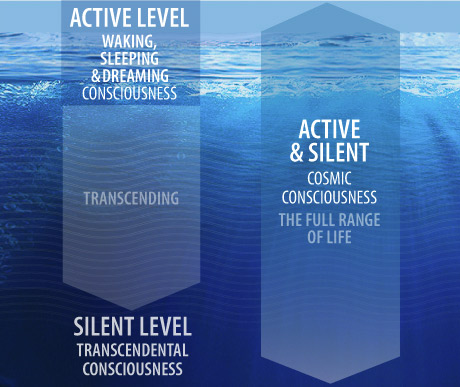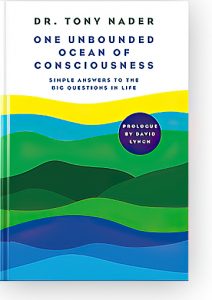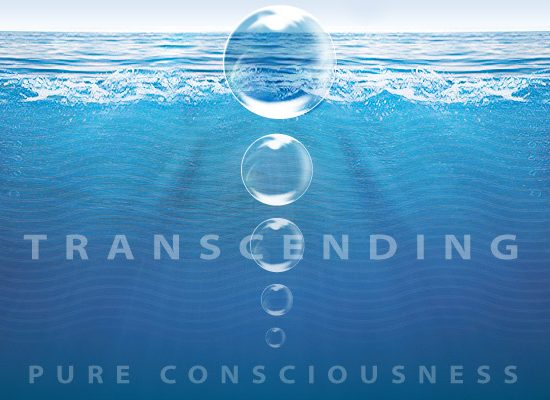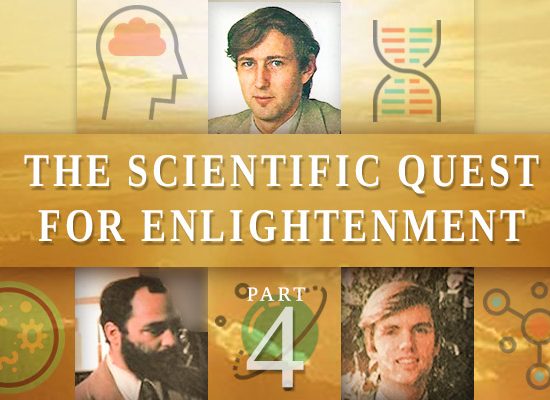“This state, in which inner silence co-exists with outward activity, Maharishi Mahesh Yogi called Cosmic Consciousness, a fifth state of Consciousness.” —Dr. Tony Nader
Tony Nader, M.D., Ph.D., M.A.R.R., a medical doctor trained at Massachusetts Institute of Technology (Ph.D. in neuroscience) and Harvard University, and the head of the international TM organizations, granted permission to reprint excerpts from Chapter 12 of his new book, One Unbounded Ocean of Consciousness: Simple Answers to the Big Questions in Life (Penguin Random House, 2021). Download the e-book at DrTonyNader.com ►
Enlightenment and Cosmic Consciousness
(Excerpts from Chapter 12)
As with many new scientific findings that upset the established apple cart of accepted principles, the early reactions to the announcement in 1970 of a discovery of “a fourth major state of consciousness” (in articles in Science, American Journal of Physiology, and Scientific American),1 were mixed. Those who had actually experienced the transcendent state were delighted to read science was recognizing its validity. Previous anecdotal reports of this experience had been dismissed by skeptics, who insisted, quite rightly, that if these reported subjective experiences of “transcendence” were to be credible, more than just “anecdotal,” they’d have to have objectively measurable physical counterparts.
As it turned out, they do.
Experience of Higher Consciousness, Inner and Outer
There is abundant scientific evidence that something unusual and significant is taking place during transcendence, not merely in the mind—it’s not just a subjective, “psychological state”—but in the body as well. As we have seen, any state of consciousness has a corresponding constellation of physiological parameters. Just as in sleep, dreaming, and wakefulness, the fourth or transcendental state also has its own unique pattern of mind-body functioning.
Metabolic and biochemical changes indicate an extremely deep state of relaxation and rest, actually more profound than sleep, as measured, for example, by very shallow natural breathing and periods of unforced breath cessation, with no compensatory over-breathing afterwards. Naturally, such a deep state of restfulness has a wide range of health-giving consequences, which have been extensively documented.

Tony Nader, M.D., Ph.D., M.A.R.R.
Yet—and this is of particular interest to me as a neuroscientist—simultaneous with the deep state of physical restfulness, awareness is lively, and a unique pattern of neurological activity appears, marked by a high degree of brain wave coherence or integration that signals an unusually balanced activation of the total brain.
This state of transcendence, known as Samadhi in the Vedic tradition, could well be considered a kind of “ground state” or foundation for higher states of Consciousness. The goal of spiritual practice is not merely to have periods of time (or, as it is subjectively felt, timelessness), when inner silence and unbounded awareness are enjoyed, but to carry that expanded and blissful state of being into all activities and relationships, to enable a true state of enlightened living. This begins as soon as transcendence is added to a person’s repertoire of experiences, and grows steadily as higher states of consciousness unfold, reaching its peak in what we’ll be calling Unity Consciousness.
This state of transcendence, known as Samadhi in the Vedic tradition, could well be considered a kind of “ground state” or foundation for higher states of Consciousness.
Since Consciousness is indeed all there is, then in its pure state, in itself, as Transcendental Consciousness, it would have to be the source of all the creativity, intelligence, and power displayed everywhere in the universe and in our individual lives as well. In support of this understanding, throughout history we find artists, poets, mathematicians, scientists, and visionaries across a wide spectrum report that it is just this experience of unboundedness, silence, bliss, and light that has inspired their unique creativity and profound insight.
“The real genius draws on the Infinite source of Wisdom and Power as Milton and Beethoven did,” said the classical composer Johannes Brahms. “Great powers like Goethe, Schiller, Milton, Tennyson, and Wordsworth received the Cosmic vibrations of eternal Truths because they linked themselves to the infinite energy of the Cosmos.”2
Artists, poets, mathematicians, scientists, and visionaries across a wide spectrum report that it is just this experience of unboundedness, silence, bliss, and light that has inspired their unique creativity and profound insight.
Infinite energy it may be, and creative dynamism—but it is also a field of tranquility and silence, the biblical “peace that passeth understanding.” The Roman general and emperor Marcus Aurelius wrote in his Meditations something that serves as a reminder for all who look for peace and inspiration outside themselves:
“Men seek retreats for themselves in country places, on beaches and mountains, and you yourself are wont to long for such retreats, but that is altogether unenlightened when it is possible at any hour you please to find a retreat within yourself. For nowhere can a man withdraw to a more untroubled quietude than in his own soul.”3
The American author and social activist Thomas Merton, a Trappist monk, described his own experience of the transcendent reality in glowing terms:
“A door opens in the center of our being and we seem to fall through it into immense depths which, although they are infinite, are all accessible to us; all eternity seems to have become ours in this one placid and breathless contact.… All variety, all complexity, all paradox, all multiplicity cease. Our mind swims in the air of an understanding, a reality that is dark and serene and includes in itself everything. Nothing more is desired. Nothing more is wanting.”4
“A door opens in the center of our being and we seem to fall through it into immense depths which, although they are infinite, are all accessible to us.” —Thomas Merton
A similar experience of transcendence was described by Gopi Krishna, an unassuming Indian civil servant in the northern state of Kashmir. After many years of dedicated meditation and yoga practice every morning before work, he had an awakening at the age of 31 and eventually wrote 16 books about Consciousness and Enlightenment that made him known worldwide. A little known fact of his life is that he was a very strong advocate for women’s rights in early twentieth-century India. In Kundalini: The Evolutionary Energy of Man, Gopi Krishna wrote:
“I felt the point of consciousness that was myself growing wider… I was now all consciousness, without any outline, without any idea of a corporeal appendage, without any feeling or sensation coming from the senses, immersed in a sea of light, simultaneously conscious and aware of every point, spread out, as it were, in all directions without any barrier or material obstruction… bathed in light and in a state of exaltation and happiness impossible to describe.”5
“I was now all consciousness… bathed in light and in a state of exaltation and happiness impossible to describe.” —Gopi Krishna
Anwar Sadat, former president of Egypt, wrote about a period early in his life when he was a political prisoner in solitary confinement. “I could only be my own companion, day and night,” he wrote, so it was “only natural that I should come to know that ‘Self’ of mine” that, like most of us, Sadat conceded, he had been too preoccupied to attend to, “hurried along by the constant stream of daily life.” In prison, with no links at all to the outside world, “the only way in which I could break my loneliness was, paradoxically, to seek the companionship of that inner entity I call ‘Self.’” The result of his inner exploration, a kind of involuntary, ongoing meditation, was that he “was able to transcend the confines of time and place. Spatially, I did not live in a four-walled cell but in the entire universe. Time ceased to exist.”
“My narrow Self ceased to exist, and the only recognizable entity was the totality of existence.” —Anwar Sadat
Reflecting on his experiences, Sadat felt that “once released from the narrow confines” of limited individuality “with its mundane suffering and petty emotions, a man will have stepped into a new, undiscovered world, which is vaster and richer. His soul would enjoy absolute freedom, uniting with existence in its entirety, transcending time and space.” For him, “my narrow Self ceased to exist, and the only recognizable entity was the totality of existence.”6 It appears that Sadat enjoyed moments of “pure” transcendence, as in meditation, and the experience of inner unboundedness also became a constant companion to his solitude.
For a remarkable collection of expressions of higher states of consciousness from many cultures and over many centuries, I recommend The Supreme Awakening by Craig Pearson.7
Cosmic Consciousness
Transcendental Consciousness is referred to in the Vedic literature as “the Fourth,” a rich addition that provides a stable yet dynamic basis to the daily cycle of wakefulness, sleep, and dreaming. The next higher step in the growth of Consciousness, called Cosmic Consciousness, occurs when, over time and through the repeated experience of transcending and coming back to ordinary activity, time and again, a person finds that awareness of the Self is not ever lost, not only during waking but also in deep sleep and dreaming. Whether in the quiet of meditation, where subtle impulses of mantra or thoughts are accompanied by the soft presence of pure awareness; or in the most dynamic phases of activity; or during the varying colors and shades of dream and sleep, awareness of the Self persists more and more steadily, as if “sticking” to the mind, until the day comes when one realizes it has become permanent.
Over time and through the repeated experience of transcending and coming back to ordinary activity, time and again, a person finds that awareness of the Self is not ever lost, not only during waking but also in deep sleep and dreaming.
Pure consciousness continues, through all the changes in one’s daily feelings, perceptions, and interactions, a steady inner presence of stability and calm. In fact, “deep sleep,” in the sense of the total obliviousness that is most people’s experience, no longer exists for such a person, because inside, unbounded awareness—the lively sense of one’s deepest being—does not ever shut down, even though physiologically, sleep continues to be completely restful.

Transcendental Consciousness along with waking, dreaming, and sleep produces a fifth state of consciousness, Cosmic Consciousness
Both the wakeful state and dreaming are different, too, because alongside them, or underlying them, is the ever-present awareness of the Self. Thus, all three common states of consciousness no longer have the same quality but are supported and enhanced by the expansive silence of Pure Consciousness. This state, in which inner silence co-exists with outward activity, Maharishi Mahesh Yogi called Cosmic Consciousness, a fifth state of Consciousness.
Like transcendence, experiences of Cosmic Consciousness have been enjoyed and described throughout history. Below, without much comment, are a few examples. I include these because I remember how descriptions of higher states of awareness were inspirational for me, helping me to persevere on my own path. Perhaps it will be helpful to you to hear other people, some prominent and some not, including individuals who have experienced higher states of consciousness through regular practice of the TM technique, speak in their own voices about how higher consciousness dawned for them and influenced their lives.
Like transcendence, experiences of Cosmic Consciousness have been enjoyed and described throughout history.
Dag Hammarskjöld, second Secretary-General of the United Nations and winner of the Nobel Peace Prize, wrote in his notebooks (later published as Markings), about his repeated experience in which “every deed and every relationship is surrounded by an atmosphere of silence,” and of his desire “to preserve the silence within—amid all the noise.” He felt this to be “a freedom in the midst of action, stillness in the midst of other human beings,” and cherished the ability to “see, judge, and act from the point of rest in ourselves,” a point “at the centre of our being.”8 These words reveal a major characteristic of Cosmic Consciousness: action supported by silence is most powerful and effective.
Many people, without rising to live Cosmic Consciousness in a permanent way, enjoy tastes of it that are life-transforming.
On a summer day, the playwright Eugene Ionesco found himself feeling extremely blissful, light, and happy. Nothing, he wrote later, “could give me greater euphoria than that of becoming aware that ‘I was,’ once and for all, and that this was an irreversible thing, an eternal miracle: the universe merely appears to be, perhaps, perhaps it is only an appearance, but ‘I am,’ I am sure of being… in a luminous sort of way, I knew and could no longer forget that I am, I myself am.”9
Nothing “could give me greater euphoria than that of becoming aware that ‘I was,’ once and for all, and that this was an irreversible thing, an eternal miracle… I knew and could no longer forget that I am, I myself am.” —Eugene Ionesco
Charlotte Wolff, a Polish-born physician, author, and pioneering researcher, experienced a period of expanded awareness during waking state when she was a young girl walking to school.
“I felt different in size, taller and larger than I really was. A wonderful sense of levitation gave me the feeling that my feet had left the ground and that I was suspended in the air. An unknown and powerful force had got hold of me… [which] gave me a feeling of omnipotence. At that moment of that day I knew the Universe, which I held and beheld inside myself… It was like a miracle… I had undergone the birth of my creative spirit and the birth of that part of the mind which reaches out beyond the material and visible world… Time did not exist in this eternal moment.”10
“I had undergone the birth of my creative spirit and the birth of that part of the mind which reaches out beyond the material and visible world… Time did not exist in this eternal moment.” —Charlotte Wolff
Wolff goes on to say that this experience changed her life in positive ways, but also notes “the doors opened themselves. But they shut again, and I possessed no key to enable me to re-enter the world I had glimpsed.”
This is, unfortunately, common to many people who come into such an experience inadvertently and feel its beauty and power, yet have no effective spiritual practice to re-ignite the bright flame of Consciousness that momentarily lit up their inner lives. What was long missing was a path that anyone can walk, to elicit such experiences and make them permanent, and this, I believe, is one of the primary results that Maharishi’s work in the world has accomplished. At this time in history, quite a large number of people seem to be “waking up” to Cosmic Consciousness, or at least temporary experiences of that state.
At this time in history, quite a large number of people seem to be “waking up” to Cosmic Consciousness, or at least temporary experiences of that state.
Advanced practitioners of TM have reported11 a different range and flavor of the experience of Cosmic Consciousness:
“I experience myself as both being connected to and an expression of Infinity, or more precisely, what I experience as a brilliant spark of that Infinity, which I feel we all are.” —D.C., TM practitioner
“The evolution of my experiences has made me a chronically happy, grateful person. On a feeling level, when I look at people and animals and things in my environment, an idea that sometimes pops into my mind is ‘Oh! That’s me in a different form!’ It’s a wonderful feeling, and I look forward to that experience on the sensory level. Life often feels like a fantastic dream.” —T.S., TM practitioner
“I experience myself as both being connected to and an expression of Infinity, or more precisely, what I experience as a brilliant spark of that Infinity, which I feel we all are.” —D.C., TM practitioner
With the advent of Cosmic Consciousness, a giant step in the evolution of awareness has taken place:
1. In waking state, the Observer observes only the objective reality, be it internal (thoughts, feelings, etc.), or external (colors, sounds, “things”). What is not observed or perceived is the Observer, the Self, Consciousness itself.
2. In Transcendental Consciousness, that objective reality temporarily vanishes, but awareness does not; awareness remains aware of itself; it is awake to itself. In this deeply restful, peaceful state, there is no objective content to the awareness other than itself; it is its own object for as long as the period of transcendence continues. And then the person returns to being aware of all the usual play of life.
3. In Cosmic Consciousness, awareness of awareness continues, but in a rather remarkable way—to experience it does not require “transcending” the relative field of objects, nor do the objects obliterate the inner wakefulness—the two fields of life, absolute inner silence and outward dynamism, co-exist. The endless finite values of the ever-changing relative field of living are supported by the infinite value of Singularity. In the midst of any activity, the individual perceives himself or herself to be Pure Consciousness.
The endless finite values of the ever-changing relative field of living are supported by the infinite value of Singularity. In the midst of any activity, the individual perceives himself or herself to be Pure Consciousness.
It is at this stage of growth that a person’s sense of identity is traditionally written with an upper-case S, to denote a qualitative distinction between the limited, finite, and ever-changing ego-personality (self), and the unbounded, ever-the-same, Pure Consciousness of the Self.
This is a true state of Enlightenment, in which the Self is “remembered” at all times—not through any effort, intention, or intellectual machinations, but naturally and spontaneously, as effortlessly as opening the eyes and seeing the landscape. It has become “established” in one’s awareness.
This is often considered the pinnacle of human development, but actually, in Maharishi’s description, there is quite a bit further to go.
Editor’s note: Learn about the next stage of enlightenment, Glorified Cosmic Consciousness, in next month’s Enjoy TM News excerpt from Dr. Nader’s book, One Unbounded Ocean of Consciousness: Simple Answers to the Big Questions in Life.
This is a true state of Enlightenment, in which the Self is “remembered” at all times—not through any effort, intention, or intellectual machinations, but naturally and spontaneously, as effortlessly as opening the eyes and seeing the landscape.
© Copyright 2021, Tony Nader, M.D., Ph.D. All rights reserved. Do not reproduce without written permission of the author.
Order One Unbounded Ocean of Consciousness at DrTonyNader.com ►
Find Dr. Nader’s talks on his Facebook page ►
Find Dr. Nader’s podcasts on iTunes ► Spotify ► SoundCloud ► and Google Play, Cashbox, and other platforms.
Notes







Each word is worth its weight in gold. Thank you very much Dr Nader for the masterpiece. But as you said in your last sentence – there is quite a bit further to go.
Looking forward to release of print version of your book.
Really beautifully written! Wow! Such clarity. Thank you. Jai Guru Dev!